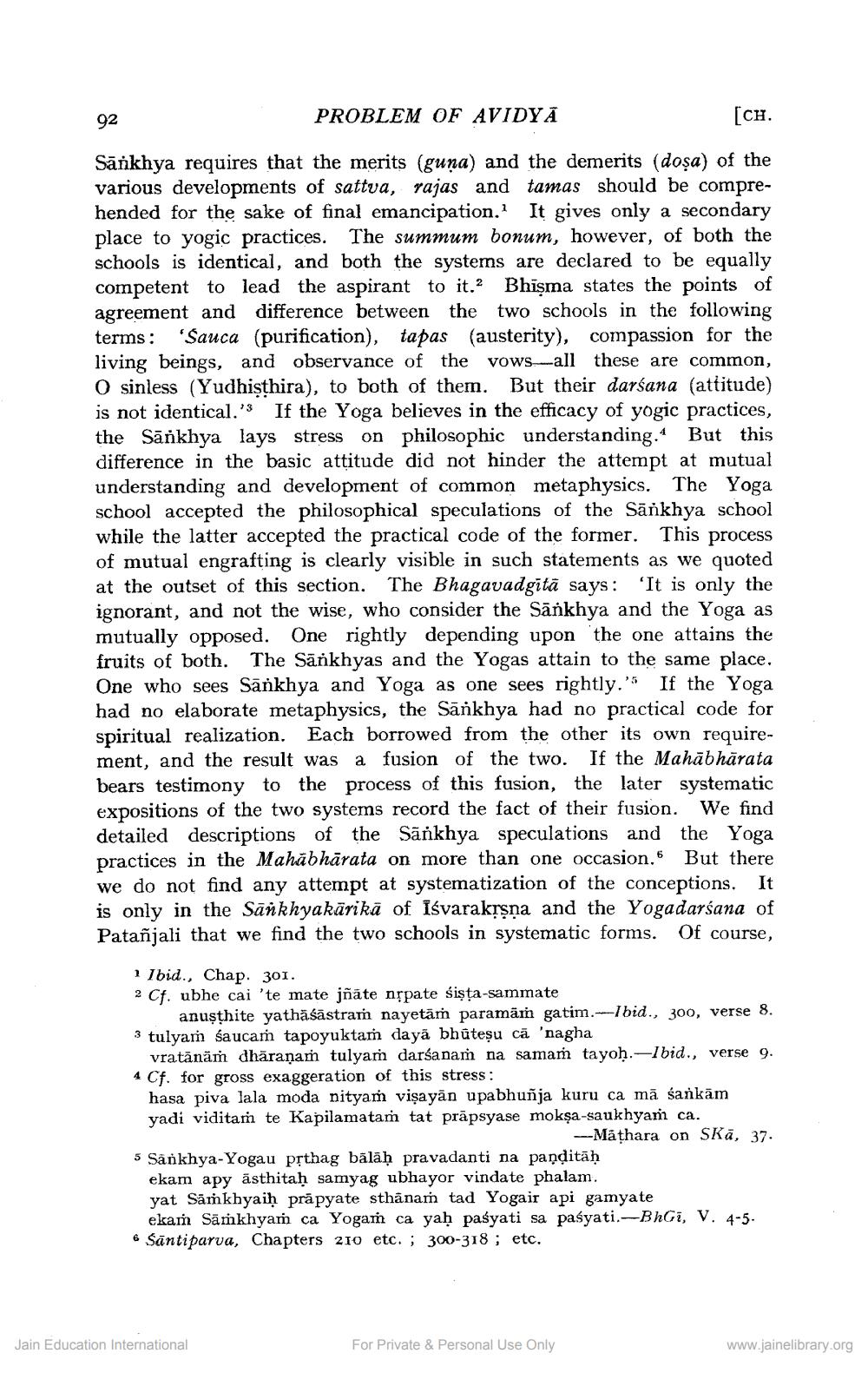________________
92
PROBLEM OF AVIDYA
[CH.
Sānkhya requires that the merits (guna) and the demerits (doşa) of the various developments of sattva, rajas and tamas should be comprehended for the sake of final emancipation. It gives only a secondary place to yogic practices. The summum bonum, however, of both the schools is identical, and both the systems are declared to be equally competent to lead the aspirant to it. Bhīşma states the points of agreement and difference between the two schools in the following terms: 'Sauca (purification), tapas (austerity), compassion for the living beings, and observance of the vows--all these are common, O sinless (Yudhisthira), to both of them. But their darśana (attitude) is not identical.'3 If the Yoga believes in the efficacy of yogic practices, the Sānkhya lays stress on philosophic understanding. But this difference in the basic attitude did not hinder the attempt at mutual understanding and development of common metaphysics. The Yoga school accepted the philosophical speculations of the Sankhya school while the latter accepted the practical code of the former. This process of mutual engrafting is clearly visible in such statements as we quoted at the outset of this section. The Bhagavadgitā says: “It is only the ignorant, and not the wise, who consider the Sankhya and the Yoga as mutually opposed. One rightly depending upon the one attains the fruits of both. The Sänkhyas and the Yogas attain to the same place, One who sees Sankhya and Yoga as one sees rightly. If the Yoga had no elaborate metaphysics, the Sankhya had no practical code for spiritual realization. Each borrowed from the other its own requirement, and the result was a fusion of the two. If the Mahābhārata bears testimony to the process of this fusion, the later systematic expositions of the two systems record the fact of their fusion. We find detailed descriptions of the Sānkhya speculations and the Yoga practices in the Mahābhārata on more than one occasion. But there we do not find any attempt at systematization of the conceptions. It is only in the Sankhyakārikā of Iśvarakrsna and the Yogadarśana of Patañjali that we find the two schools in systematic forms. Of course,
1 Ibid., Chap. 301. 2 Cf. ubhe cai 'te mate jñāte nộpate sista-sammate
anuşthite yathāśāstrarn nayetām paramām gatim.-Ibid., 300, verse 8. 3 tulyam saucam tapoyuktam dayā bhūteņu cä 'nagha
vratānāṁ dhäraņam tulyam darśanam na sama tayoh.-Ibid., verse 9. 4 Cf. for gross exaggeration of this stress: hasa piva lala moda nityam viņayān upabhuñja kuru ca mā sankām yadi viditam te Kapilamatam tat prāpsyase mokşa-saukhyam ca.
---Mathara on Skā, 37. 5 Sankhya-Yogau prthag bālāḥ pravadanti na panditāḥ
ekam apy ästhitaḥ samyag ubhayor vindate phalam. yat Sāṁkhyaiḥ prāpyate sthānam tad Yogair api gamyate
ekam Samkhyam ca Yogam ca yaḥ paśyati sa paśyati.-BhGi, V. 4-5. 6 śāntiparva, Chapters 210 etc. ; 300-318 ; etc.
Jain Education International
For Private & Personal Use Only
www.jainelibrary.org




